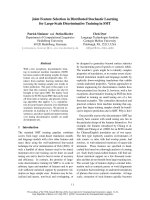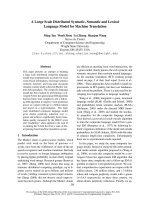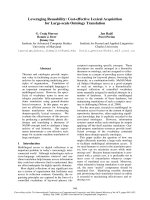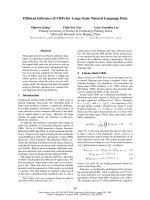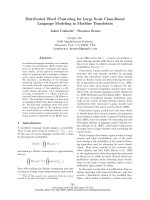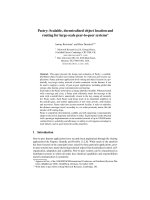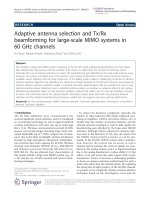Algorithms for large scale nuclear norm minimization and convex quadratic semidefinite programming problems
Bạn đang xem bản rút gọn của tài liệu. Xem và tải ngay bản đầy đủ của tài liệu tại đây (1.15 MB, 163 trang )
ALGORITHMS FOR LARGE SCALE
NUCLEAR NORM MINIMIZATION AND
CONVEX QUADRATIC SEMIDEFINITE
PROGRAMMING PROBLEMS
JIANG KAIFENG
(B.Sc., NJU, China)
A THESIS SUBMITTED
FOR THE DEGREE OF DOCTOR OF PHILOSOPHY
DEPARTMENT OF MATHEMATICS
NATIONAL UNIVERSITY OF SINGAPORE
2011
To my parents
Acknowledgements
I would like to express my sincerest thanks to my supervisor Professor Toh Kim
Chuan for his invaluable guidance and perpetual encouragement and support. I
have benefited intellectually from his fresh ideas and piercing insights in scientific
research, as well as many enjoyable discussions we had during the past four years.
He always encourages me to do research independently, even though sometimes I was
lack of confidence in myself. I am very grateful to him for providing me extensive
training in the field of numerical computation. I am greatly indebted to him.
I would like to thank Professor Sun Defeng for his great effort on conducting
weekly optimization research seminars, which have significantly enriched my knowl-
edge of the theory, algorithms and applications of optimization. His amazing depth
of knowledge and tremendous expertise in optimization has greatly facilitated my
research progress. I feel very honored to have an opportunity of doing research with
him.
I would like to thank Professor Zhao Gongyun for his instruction on mathemat-
ical programming, which is the first module I took during my first year in NUS. His
excellent teaching style helps me to gain broad knowledge of numerical optimiza-
tion and software. I am very thankful to him for sharing with me his wonderful
mathematical insights and research experience in the field of optimization.
v
vi Acknowledgements
I would like to thank Department of Mathematics and National University of
Singapore for providing me excellent research conditions and scholarship to com-
plete my PhD study. I also would like to thank Faculty of Science for providing
me financial support for attending the 2011 SIAM conference on optimization in
Darmstadt, Germany.
Finally, I would like to thank all my friends in Singapore for their long-time en-
couragement and support. Many thanks go to Dr. Liu Yongjin, Dr. Zhao Xinyuan,
Dr. Li Lu, Dr. Gao Yan, Dr. Yang Junfeng, Ding Chao, Miao Weimin, Gong Zheng,
Shi Dongjian, Wu Bin, Chen Caihua, Li Xudong, Du Mengyu for their helpful dis-
cussions in many interesting optimization topics related to my research.
Contents
Acknowledgements v
Summary xi
1 Introduction 1
1.1 Nuclear norm regularized matrix least squares problems . . . . . . . . 2
1.1.1 Existing models and related algorithms . . . . . . . . . . . . . 3
1.1.2 Motivating examples . . . . . . . . . . . . . . . . . . . . . . . 6
1.2 Convex semidefinite programming problems . . . . . . . . . . . . . . 7
1.3 Contributions of the thesis . . . . . . . . . . . . . . . . . . . . . . . . 12
1.4 Organization of the thesis . . . . . . . . . . . . . . . . . . . . . . . . 15
2 Preliminaries 17
2.1 Notations . . . . . . . . . . . . . . . . . . . . . . . . . . . . . . . . . 17
2.2 Metric projectors . . . . . . . . . . . . . . . . . . . . . . . . . . . . . 19
2.3 The soft thresholding operator . . . . . . . . . . . . . . . . . . . . . . 20
2.4 The smoothing counterpart . . . . . . . . . . . . . . . . . . . . . . . 28
vii
viii Contents
3 Nuclear norm regularized matrix least squares problems 37
3.1 The general proximal point algorithm . . . . . . . . . . . . . . . . . . 37
3.2 A partial proximal point algorithm . . . . . . . . . . . . . . . . . . . 41
3.3 Convergence analysis of the partial PPA . . . . . . . . . . . . . . . . 50
3.4 An inexact smoothing Newton method for inner subproblems . . . . . 54
3.4.1 Inner subproblems . . . . . . . . . . . . . . . . . . . . . . . . 54
3.4.2 An inexact smoothing Newton method . . . . . . . . . . . . . 57
3.4.3 Constraint nondegeneracy and quadratic convergence . . . . . 59
3.5 Efficient implementation of the partial PPA . . . . . . . . . . . . . . 66
4 A semismooth Newton-CG method for unconstrained inner sub-
problems 71
4.1 A semismooth Newton-CG method . . . . . . . . . . . . . . . . . . . 72
4.2 Convergence analysis . . . . . . . . . . . . . . . . . . . . . . . . . . . 77
4.3 Symmetric matrix problems . . . . . . . . . . . . . . . . . . . . . . . 78
5 An inexact APG method for linearly constrained convex SDP 81
5.1 An inexact accelerated proximal gradient method . . . . . . . . . . . 82
5.1.1 Specialization to the case where g = δ(·|Ω) . . . . . . . . . . 89
5.2 Analysis of an inexact APG method for (P ) . . . . . . . . . . . . . . 91
5.2.1 Boundedness of {p
k
} . . . . . . . . . . . . . . . . . . . . . . . 99
5.2.2 A semismooth Newton-CG method . . . . . . . . . . . . . . . 101
6 Numerical Results 105
6.1 Numerical Results for nuclear norm minimization problems . . . . . . 105
6.2 Numerical Results for linearly constrained QSDP problems . . . . . . 125
7 Conclusions 133
Contents ix
Bibliography 135
Summary
This thesis focuses on designing efficient algorithms for solving large scale struc-
tured matrix optimization problems, which have many applications in a wide range
of fields, such as signal processing, system identification, image compression, molec-
ular conformation, sensor network localization and so on. We introduce a partial
proximal point algorithm, in which only some of the variables appear in the quadratic
proximal term, for solving nuclear norm regularized matrix least squares problems
with linear equality and inequality constraints. We establish the global and local
convergence of our proposed algorithm based on the results for the general par-
tial proximal point algorithm. The inner subproblems, reformulated as a system of
semismooth equations, are solved by an inexact smoothing Newton method, which
is proved to be quadratically convergent under the constraint nondegeneracy con-
dition, together with the strong semismoothness property of the soft thresholding
operator.
As a special case where the nuclear norm regularized matrix least squares prob-
lem has equality constraints only, we introduce a semismooth Newton-CG method
to solve the unconstrained inner subproblem in each iteration. We show that the
positive definiteness of the generalized Hessian of the objective function in the in-
ner subproblem is equivalent to the constraint nondegeneracy of the corresponding
xi
xii Summary
primal problem, which is a key property for applying the semismooth Newton-CG
method to solve the inner subproblems efficiently. The global and local superlinear
(quadratic) convergence of the semismooth Newton-CG method is also established.
To solve large scale convex quadratic semidefinite programming (QSDP) prob-
lems, we extend the accelerated proximal gradient (APG) method to the inexact
setting where the subproblem in each iteration is progressively solved with suffi-
cient accuracy. We show that the inexact APG method enjoys the same superior
convergent rate of O(1/k
2
) as the exact version.
Extensive numerical experiments on a variety of large scale nuclear norm reg-
ularized matrix least squares problems show that our proposed partial proximal
point algorithm is very efficient and robust. We can successfully find a low rank
approximation of the target matrix while maintaining the desired linear structure
of the original system. Numerical experiments on some large scale convex QSDP
problems demonstrate the high efficiency and robustness of the proposed inexact
APG algorithm. In particular, our inexact APG algorithm can efficiently solve the
H-weighted nearest correlation matrix problem, where the given weight matrix H
is highly ill-conditioned.
Chapter 1
Introduction
In this thesis, we focus on designing algorithms for solving large scale structured
matrix optimization problems. In particular, we are interested in nuclear norm reg-
ularized matrix least squares problems and linearly constrained convex semidefinite
programming problems. Let
p×q
be the space of all p × q matrices equipped with
the standard trace inner product and its induced Frobenius norm ·. The general
structured matrix optimization problem we consider in this thesis can be stated as
follows:
min
f(X) + g(X) : X ∈
p×q
, (1.1)
where f :
p×q
→ and g :
p×q
→ ∪ {+∞} are proper, lower semi-continuous
convex functions (possibly nonsmooth). In many applications, such as statistical
regression and machine learning, f is a loss function which measures the difference
between the observed data and the value provided by the model. The quadratic
loss function, e.g., the linear least squares loss function, is a common choice. The
function g, which is generally nonsmooth, favors certain desired properties of the
computed solution, and it can be chosen by the user based on the available prior
information about the target matrix. In practice, the data matrix X, which describes
the original system, has some or all of the following properties:
1. The computed solution X should be positive semidefinite;
1
2 Chapter 1. Introduction
2. In order to reduce the complexity of the whole system, X should be of low
rank;
3. Some entries of X are in the confidence interval which indicates the reliability
of the statistical estimation;
4. All entries of X should be nonnegative because they correspond to physically
nonnegative quantities such as density or image intensity;
5. X belongs to some special classes of matrices, e.g., Hankel matrices arising
from linear system realization, (doubly) stochastic matrices which describe
the transition probability of a Markov chain, and so on.
1.1 Nuclear norm regularized matrix least squares
problems
In the first part of this thesis, we consider the following nuclear norm regularized
matrix least squares problem with linear equality and inequality constraints:
min
X∈
p×q
1
2
A(X) −b
2
+ C, X+ ρX
∗
s.t. B(X) ∈ d + Q,
(1.2)
where X
∗
denotes the nuclear norm of X defined as the sum of all its singular
values, A :
p×q
→
m
and B :
p×q
→
s
are linear maps, C ∈
p×q
, b ∈
m
, d ∈
s
, ρ is a given positive parameter, and Q = {0}
s
1
×
s
2
+
is a polyhedral convex
cone with s = s
1
+ s
2
. In this case, the convex functions f and g in (1.1) are of the
following forms:
f(X) =
1
2
A(X) −b
2
+ C, X and g(X) = ρX
∗
+ δ(X |D
1
),
where D
1
= {X ∈
p×q
|B(X) ∈ d + Q} is the feasible set of (1.2) and δ(·|D
1
) is
the indicator function on the set D
1
. In many applications, such as signal processing
[68, 111, 112, 129], molecular structure modeling for protein folding [86, 87, 122] and
1.1 Nuclear norm regularized matrix least squares problems 3
computation of the greatest common divisor (GCD) of unvariate polynomials [27, 62]
from computer algebra, we need to find a low rank approximation of a given target
matrix while preserving certain structures. The nuclear norm function has been
widely used as a regularizer which favors a low rank solution of (1.2). In [25], Chu,
Funderlic and Plemmons addressed some theoretical and numerical issues concerning
structured low rank approximation problems. In many data analysis problems, the
collected empirical data, possibly contaminated by noise, usually do not have the
specified structure or the desired low rank. So it is important to find the nearest low
rank approximation of the given matrix while maintaining the underlying structure
of the original system. In practice, the data to be analyzed is very often nonnegative
such as those corresponding to concentrations or intensity values, and it would be
preferable to take into account such structural constraints.
1.1.1 Existing models and related algorithms
In this subsection, we give a brief review of existing models involving the nuclear
norm function and related variants. Recently there are intensive studies on the
following affine rank minimization problem:
min
rank(X) : A(X) = b, X ∈
p×q
. (1.3)
The problem (1.3) has many applications in diverse fields, see, e.g., [1, 2, 19, 37,
44, 82, 102]. (Note that there are some special rank approximation problems that
have known solutions. For example, the low rank approximation of a given matrix
in Frobenius norm can be derived via singular value decomposition by the classic
Eckart-Young Theorem [35].) However, this affine rank minimization problem is
generally an NP-hard nonconvex optimization problem. A tractable heuristic intro-
duced in [36, 37] is to minimize the nuclear norm over the same constraints as in
(1.3):
min
X
∗
: A(X) = b, X ∈
p×q
. (1.4)
4 Chapter 1. Introduction
The nuclear norm function is the greatest convex function majorized by the rank
function over the unit ball of matrices with operator norm at most one. In [19, 21,
51, 63, 101, 102], the authors established remarkable results which state that under
suitable incoherence assumptions, a p × q matrix of rank r can be recovered with
high probability from uniformly random sampled entries of size slightly larger than
O((p + q)r) by solving (1.4). A frequently used alternative to (1.4) for accommo-
dating problems with noisy data is to consider solving the following matrix least
squares problem with nuclear norm regularization (see [77, 121]):
min
1
2
A(X) −b
2
+ ρX
∗
: X ∈
p×q
, (1.5)
where ρ is a given positive parameter. It is known that (1.4) or (1.5) can be equiv-
alently reformulated as a semidefinite programming (SDP) problem (see [36, 102]),
which has one (p + q) × (p + q) semidefinite constraint and m linear equality con-
straints. One can use standard interior-point method based semidefinite program-
ming solvers such as SeDuMi [114] and SDPT3 [119] to solve this SDP problem.
However, these solvers are not suitable for problems with large p + q or m since in
each iteration of these solvers, a large and dense Schur complement equation must
be solved for computing the search direction even when the data is sparse.
To overcome the difficulties faced by interior-point methods, several algorithms
have been proposed to solve (1.4) or (1.5) directly. In [102], Recht, Fazel and
Parrilo considered the projected subgradient method to solve (1.4). However, the
convergence of the projected subgradient method considered in [102] is still unknown
since problem (1.4) is a nonsmooth problem, and the convergence is observed to be
very slow for large scale matrix completion problems. Recht, Fazel and Parrilo [102]
also considered the method of using the low-rank factorization technique introduced
by Burer and Monteiro [15, 16] to solve (1.4). The advantage of this method is
that it requires less computer memory for solving large scale problems. However,
the potential difficulty of this method is that the low rank factorization formulation
is nonconvex and the rank of the optimal matrix is generally unknown. In [17],
Cai, Cand`es and Shen proposed a singular value thresholding (SVT) algorithm for
1.1 Nuclear norm regularized matrix least squares problems 5
solving the following Tikhonov regularized version of (1.4):
min
τX
∗
+
1
2
X
2
: A(X) = b, X ∈
p×q
, (1.6)
where τ is a given positive parameter. The SVT algorithm is a gradient method
applied to the dual problem of (1.6). Ma, Goldfarb and Chen [77] proposed a fixed
point algorithm with continuation (FPC) for solving (1.5) and a Bregman iterative
algorithm for solving (1.4). Their numerical results on randomly generated matrix
completion problems demonstrated that the FPC algorithm is much more efficient
than the semidefinite programming solver SDPT3. In [121], Toh and Yun proposed
an accelerated proximal gradient algorithm (APG), which terminates in O(1/
√
ε)
iterations for achieving ε-optimality (in terms of the function value), to solve the
unconstrained matrix least squares problem (1.5). Their numerical results show
that the APG algorithm is highly efficient and robust in solving large-scale random
matrix completion problems. In [71], Liu, Sun and Toh considered the following
nuclear norm minimization problem with linear and second order cone constraints:
min
X
∗
: A(X) ∈ b + K, X ∈
p×q
, (1.7)
where K = {0}
m
1
×K
m
2
, and K
m
2
stands for the m
2
-dimensional second order cone
(or ice-cream cone, or Lorentz cone) defined by
K
m
2
:= {x = (x
0
;
x) ∈ ×
m
2
−1
: x ≤ x
0
}.
They developed three inexact proximal point algorithms (PPA) in the primal, dual
and primal-dual forms with comprehensive convergence analysis built upon the clas-
sic results of the general PPA established by Rockafellar [108, 107]. Their numerical
results demonstrated the efficiency and robustness of these three forms of PPA in
solving randomly generated matrix completion problems and real matrix completion
problems. Moreover, they showed that the SVT algorithm [17] is just one outer it-
eration of the exact primal PPA, and the Bregman iterative method [77] is a special
case of the exact dual PPA.
6 Chapter 1. Introduction
However, all the above mentioned models and related algorithms cannot address
the following goal: given the observed data matrix (possibly contaminated by noise),
we want to find the nearest low rank approximation of the target matrix while
maintaining the prescribed structure of the original system. In particular, the APG
method considered in [121] cannot be applied directly to solve (1.2).
1.1.2 Motivating examples
A strong motivation for proposing the model (1.2) arises from finding the nearest
low rank approximation of transition matrices. For a given data matrix
P which
describes the full distribution of a random walk through the entire data set, the
problem of finding the low rank approximation of
P can be stated as follows:
min
X∈
n×n
1
2
X −
P
2
+ ρX
∗
: Xe = e, X ≥ 0
, (1.8)
where e ∈
n
is the vector of all ones and X ≥ 0 denotes the condition that all
entries of X are nonnegative. In [70], Lin proposed the Latent Markov Analysis
(LMA) approach for finding the reduced rank approximations of transition matri-
ces. The LMA is applied to clustering such that the inferred cluster relationships
can be described probabilistically by the reduced-rank transition matrix. In [24],
Chennubhotla exploited the spectral properties of the Markov transition matrix to
obtain low rank approximation of the original transition matrix in order to develop
a fast eigen-solver for spectral clustering. Another application of finding the low
rank approximation of the transition matrix comes from computing the personalized
PageRank [6] which describes the backlink-based page quality around user-selected
pages. In many applications, since only partial information of the original transition
matrix is available, it is also important to estimate the missing entries of
P . For
example, transition probabilities between different credit ratings play a crucial role
in the credit portfolio management. If our primary interest is in a specific group, the
number of observations of available rating transitions is very small. Due to lack of
rating data, it is important to estimate the rating transition matrix in the presence
1.2 Convex semidefinite programming problems 7
of missing data [5, 59].
Another strong motivation for considering the model (1.2) comes from finding
low rank approximations of doubly stochastic matrices with a prescribed entry. A
matrix M ∈
n×n
is called doubly stochastic if it is nonnegative and all its row and
column sums are equal to one. Then the problem for matching the first moment of
M with sparsity pattern E can be stated as follows:
min
X∈
n×n
1
2
X
E
−
M
E
2
+ ρX
∗
: Xe = e, X
T
e = e, X
11
= M
11
, X ≥ 0
, (1.9)
where
M
E
dentoes the partially observed data (possibly with noise). This problem
arose from numerical simulation of large circuit networks. In order to reduce the
complexity of the simulation of the whole system, the Pad´e approximation with
Krylov subspace method, such as the Lanczos algorithm, is a useful tool for gen-
erating a lower order approximation to the linear system matrix which describes
the large linear network [3]. The tridiagonal matrix M produced by the Lanczos
algorithm generally is not doubly stochastic. If the original system matrix is doubly
stochastic, then we need to find a low rank approximation of M such that it is
doubly stochastic and matches the first moment of M.
1.2 Convex semidefinite programming problems
In the second part of this thesis, we consider the following linearly constrained
convex semidefinite programming problem:
min
X∈S
n
f(X)
s.t. A(X) = b, (1.10)
X 0,
where f is a smooth convex function on S
n
, A : S
n
→ R
m
is a linear map, b ∈ R
m
,
and S
n
is the space of n × n symmetric matrices equipped with the standard trace
inner product. The notation X 0 means that X is positive semidefinite. In this
8 Chapter 1. Introduction
case, the function g in (1.1) takes the form: g(X) = δ(X |D
2
), where D
2
= {X ∈
S
n
|A(X) = b, X 0} is the feasible set of (1.10). Let A
∗
be the adjoint of A.
The dual problem associated with (1.10) is given by
max f(X) −∇f(X), X + b, p
s.t. ∇f(X) − A
∗
p −Z = 0, (1.11)
p ∈
m
, Z 0, X 0.
The problem (1.10) contains the following important special case of convex quadratic
semidefinite programming (QSDP):
min
1
2
X, Q(X) + C, X : A(X) = b, X 0
, (1.12)
where Q : S
n
→ S
n
is a given self-adjoint positive semidefinite linear operator and
C ∈ S
n
. The Lagrangian dual problem of (1.12) is given by
max
−
1
2
X, Q(X) + b, p : A
∗
(p) −Q(X) + Z = C, Z 0
. (1.13)
A typical example of QSDP is the nearest correlation matrix problem [55], where
given a symmetric matrix U ∈ S
n
and a linear map L : S
n
→ R
n×n
, we want to
solve
min
1
2
L(X − U)
2
: Diag(X) = e, X 0
, (1.14)
where e ∈
n
is the vector of all ones. If we let Q = L
∗
L and C = −L
∗
L(U) in
(1.14), then we get the QSDP problem (1.12). A well studied special case of (1.14)
is the W -weighted nearest correlation matrix problem, where L = W
1/2
W
1/2
for a given W ∈ S
n
++
and Q = W W . Note that for U ∈
n×r
, V ∈
n×s
,
U V :
r×s
→ S
n
is the symmetrized Kronecker product linear map defined by
U V (M) = (UMV
T
+ V M
T
U
T
)/2.
There are several methods available for solving (1.14), which include the alter-
nating projection method [55], the quasi-Newton method [78], the inexact semis-
mooth Newton-CG method [97] and the inexact interior-point method [120]. All
these methods, excluding the inexact interior-point method, rely critically on the
1.2 Convex semidefinite programming problems 9
fact that the projection of a given matrix X ∈ S
n
onto S
n
+
has an analytical formula
with respect to the norm W
1/2
(·)W
1/2
. However, all above mentioned techniques
cannot be extended to efficiently solve the H-weighted case [55] of (1.14), where
L(X) = H ◦X for some H ∈ S
n
with nonnegative entries and Q(X) = (H ◦H) ◦X,
with “◦” denoting the Hardamard product of two matrices defined by (A ◦ B)
ij
=
A
ij
B
ij
. In [50], a H-weighted kernel matrix completion problem of the form
min
H ◦ (X − U) | A(X) = b, X 0
(1.15)
is considered, where U ∈ S
n
is a given kernel matrix with missing entries. The
aforementioned methods are not well suited for the H-weighted case of (1.14) because
there is no explicitly computable formula for the following problem
min
1
2
H ◦ (X − U)
2
: X 0
, (1.16)
where U ∈ S
n
is a given matrix. To tackle the H-weighted case of (1.14), Toh
[118] proposed an inexact interior-point method for a general convex QSDP includ-
ing the H-weighted nearest correlation matrix problem. Recently, Qi and Sun [98]
introduced an augmented Lagrangian dual method for solving the H-weighted ver-
sion of (1.14), where the inner subproblem was solved by a semismooth Newton-CG
(SSNCG) method. In her PhD thesis, Zhao [137] designed a semismooth Newton-
CG augmented Lagrangian method and analyzed its convergence for solving convex
quadratic programming over symmetric cones. The augmented Lagrangian dual
method avoids solving (1.16) directly and it can be much faster than the inexact
interior-point method [118]. However, if the weight matrix H is very sparse or
ill-conditioned, the conjugate gradient (CG) method would have great difficulty in
solving the linear system of equations in the semismooth Newton method, and the
augmented Lagrangian method would not be efficient or even fail. Another draw-
back of the augmented Lagrangian dual method in [98] is that the computed solution
X usually is not positive semidefinite. A post processing step is generally needed to
make the computed solution positive semidefinite.
10 Chapter 1. Introduction
Another example of QSDP comes from the civil engineering problem of esti-
mating a positive semidefinite stiffness matrix for a stable elastic structure from r
measurements of its displacements {u
1
, . . . , u
r
} ⊂
n
in response to a set of static
loads {f
1
, . . . , f
r
} ⊂
n
[130]. In this application, one is interested in the QSDP
problem:
min
f − L(X)
2
: X 0
, (1.17)
where L : S
n
→
n×r
is defined by L(X) = XU, and f = [f
1
, . . . , f
r
], U =
[u
1
, . . . , u
r
]. In this case, the corresponding map Q = L
∗
L is given by Q(X) =
(XB + BX)/2 with B = UU
T
.
The main purpose of the second part of this thesis is to design an efficient
algorithm to solve the problem (1.10). The algorithm we propose here is based
on the APG method of Beck and Teboulle [4] (the method is called FISTA in [4]),
where in the kth iteration with iterate X
k
, a subproblem of the following form must
be solved:
min
∇f(X
k
), X −X
k
+
1
2
X −X
k
, H
k
(X −X
k
) : A(X) = b, X 0
, (1.18)
where H
k
: S
n
→ S
n
is a given self-adjoint positive definite linear operator. In
FISTA [4], H
k
is restricted to LI, where I : S
n
→ S
n
denotes the identity map
and L is a Lipschitz constant of ∇f. More significantly, for FISTA in [4], the
subproblem (1.18) must be solved exactly to generate the next iterate X
k+1
. In
this thesis, we design an inexact APG method which overcomes the two limitations
just mentioned. Specifically, in our inexact algorithm, the subproblem (1.18) is
only solved approximately and H
k
is not restricted to be a scalar multiple of I. In
addition, we are able to show that if the subproblem (1.18) is progressively solved
with sufficient accuracy, then the number of iterations needed to achieve ε-optimality
(in terms of the function value) is also proportional to 1/
√
ε, just as in the exact
version of the APG method.
Another strong motivation for designing an inexact APG algorithm comes from
1.2 Convex semidefinite programming problems 11
the recent paper [22], which considered the following regularized inverse problem:
min
x∈
p
1
2
Φx −y
2
+ λx
B
, (1.19)
where Φ : R
p
→ R
n
is a given linear map and x
B
is the atomic norm induced
by a given compact set of atoms B in R
p
. It appears that the APG algorithm is
highly suitable for solving (1.19). Note that in each iteration of the APG algorithm,
a subproblem of the form
min
z∈
p
µz
B
+
1
2
z −x
2
≡ min
y∈
p
1
2
y − x
2
| y
∗
B
≤ µ
must be solved, where ·
∗
B
is the dual norm of ·
B
. However, for most choices
of B, the subproblem does not admit an analytical solution and has to be solved
numerically. As a result, the subproblem is never solved exactly. In fact, it may
be computationally very expensive to solve the subproblem to high accuracy. Our
inexact APG algorithm thus has the attractive computational advantage that the
subproblems need only be solved with progressively better accuracy while still main-
taining the global iteration complexity.
Finally we should mention that the fast gradient method of Nesterov [90] has
also been extended in [30] to the problem
min{f(x) | x ∈ Q}, (1.20)
where the function f is convex (not necessarily smooth) on the closed convex set Q,
and is equipped with the so-called first-order (δ, L)-oracle where for any y ∈ Q, we
can compute a pair (f
δ,L
(y), g
δ,L
(y)) such that
0 ≤ f(x) −f
δ,L
(y) − g
δ,L
(y), x − y ≤
L
2
x −y
2
+ δ ∀ x ∈ Q.
In the inexact-oracle fast gradient method in [30], the subproblem of the form
min
g
δ,L
(y), x − y +
L
2
x −y
2
| x ∈ Q
in each iteration must be solved exactly. Thus the kind of the inexactness considered
in [30] is very different from what we consider in this thesis.
12 Chapter 1. Introduction
1.3 Contributions of the thesis
In the first part of this thesis, we study a partial proximal point algorithm (PPA) for
solving (1.2), in which only some of the variables appear in the quadratic proximal
term. Based on the results of the general partial PPA studied by Ha [52], we analyze
the global and local convergence of our proposed partial PPA for solving (1.2). In
[52], Ha presented a modification of the general PPA studied by Rockafellar [108], in
which only some variables appear in the proposed iterative procedure. The partial
PPA was further analyzed by Bertsekas and Tseng [11], in which the close rela-
tion between the partial PPA and some parallel algorithms in convex programming
was revealed. In [60], Ibaraki and Fukushima proposed two variants of the partial
proximal method of multipliers for solving convex programming problems with lin-
ear constraints only, in which the objective function is separable. The convergence
analysis of their proposed two variants of algorithms is built upon the results of the
partial PPA by Ha [52]. We note that the proposed partial PPA requires solving an
inner subproblem with linear inequality constraints at each iteration. To handle the
inequality constraints, Gao and Sun [42] recently designed a quadratically conver-
gent inexact smoothing Newton method, which was used to solve the least squares
semidefinite programming with equality and inequality constraints. Their numerical
results demonstrated the high efficiency of the inexact smoothing Newton method.
This strongly motivated us to use the inexact smoothing Newton method to solve
inner subproblems for achieving fast convergence. For the inner subproblem, due
to the presence of inequality constraints, we reformulate the problem as a system
of semismooth equations. By defining a smoothing function for the soft threshold-
ing operator, we then introduce an inexact smoothing Newton method to solve the
semismooth system, where at each iteration the BiCGStab iterative solver is used
to approximately solve the generated linear system. Based on the classic results of
nonsmooth analysis by Clarke [26], we study the properties of the epigraph of the
nuclear norm function, and develop a constraint nondegeneracy condition, which
1.3 Contributions of the thesis 13
provides a theoretical foundation for the analysis of the quadratic convergence of
the inexact smoothing Newton method.
When the nuclear norm regularized matrix least squares problem (1.2) has equal-
ity constraints only, we introduce a semismooth Newton-CG method, which is prefer-
able to the inexact smoothing Newton method for solving unconstrained inner sub-
problems. We are able to show that the positive definiteness of the generalized
Hessian of the objective function of inner subproblems is equivalent to the con-
straint nondegeneracy of the corresponding primal problems, which is an important
property for successfully applying the semismooth Newton-CG method to solve inner
subproblems. The quadratic convergence of the semismooth Newton-CG method is
established under the constraint nondegeneracy condition, together with the strong
semismoothness property of the soft thresholding operator.
In the second part of this thesis, we focus on designing an efficient algorithm for
solving the linearly constrained convex semidefinite programming problem (1.10). In
recent years there are intensive studies on the theories, algorithms and applications
of large scale structured matrix optimization problems. The accelerated proximal
gradient (APG) method, first proposed by Nesterov [90], later refined by Beck and
Teboulle [4], and studied in a unifying manner by Tseng [123], has proven to be
highly efficient in solving some classes of large scale structured convex optimization
problems. The method has superior convergent rate of O(1/k
2
) over the classical
projected gradient method [47, 67]. Our proposed algorithm is based on the APG
method introduced by Beck and Teboulle [4] (named FISTA in [4]), where the sub-
problem of the form in (1.18) must be solved in each iteration. A limitation of the
FISTA method in [4] is that the positive definite linear operator H
k
is restricted to
LI, where I : S
n
→ S
n
denotes the identity map and L is a Lipschitz constant of
∇f. Note that the number of iterations needed by FISTA to achieve ε-optimality (in
terms of the function value) is proportional to
L/ε. In many applications, the Lip-
schitz constant L of ∇f is very large, which will cause the FISTA method to converge
very slowly for obtaining a good approximate solution. A more significant limitation
